Direction of Arrival (DOA) Estimation Using a Deep Unfolded Learned Iterative Shrinkage Thresholding Algorithm (LISTA) Network in a Non-Uniform Metasurface
Abstract
:1. Introduction
2. Signal Model
2.1. Non-Uniform Metasurface Model
2.2. Space–Time Modulation of Received Signal
3. Proposed Algorithm
3.1. Data Preprocessing
3.2. Proposed Network
3.3. Network Training
4. Simulation Results
4.1. Details of Experiments
4.2. Determination of Parameters
4.3. Determination of Hardware
4.4. Performance Analysis
4.4.1. Validity Analysis
4.4.2. Convergence Rate Analysis
4.4.3. Generalization Capability Analysis
4.5. Estimated Accuracy Comparison
4.5.1. Performance Analysis Under Different SNRs
4.5.2. Performance Analysis Under Different Snapshots
4.6. Computational Cost Analysis
5. Conclusions
Author Contributions
Funding
Data Availability Statement
Acknowledgments
Conflicts of Interest
References
- Huan, M.; Liang, J.; Ma, Y.; Liu, W.; Wu, Y.; Zeng, Y. Optimization of High-Resolution and Ambiguity-Free Sparse Planar Array Geometry for Automotive MIMO Radar. IEEE Trans. Signal Process. 2024, 72, 4332–4348. [Google Scholar] [CrossRef]
- Lai, X.; Zhang, X.; Liu, W.; Li, J. Sparse Enhancement of MIMO Radar Exploiting Moving Transmit and Receive Arrays for DOA Estimation: From the Perspective of Synthetic Coarray. IEEE Trans. Signal Process. 2024, 72, 4022–4036. [Google Scholar] [CrossRef]
- Zhu, H.; Feng, W.; Feng, C.; Ma, T.; Zou, B. Deep Unfolded Gridless DOA Estimation Networks Based on Atomic Norm Minimization. Remote Sens. 2022, 15, 13. [Google Scholar] [CrossRef]
- Fang, Z.; Zhou, Q.; Dai, J.Y.; Qi, Z.J.; Zhang, J.; Cheng, Q.; Cui, T.J. DOA Estimation Method Based on Space-Time Coding Antennas with Orthogonal Codes. IEEE Trans. Antennas Propag. 2024, 72, 1173–1181. [Google Scholar] [CrossRef]
- Zhan, Q.; Li, S.; Yan, B.; Cao, A.; Bai, X.; He, C. Spatial Spectrum Direction Finding by Programmable Metasurface with Time Modulation. IEEE Antennas Wirel. Propag. Lett. 2024, 23, 458–462. [Google Scholar] [CrossRef]
- He, C.; Cao, A.; Chen, J.; Liang, X.; Zhu, W.; Geng, J.; Jin, R. Direction Finding by Time-Modulated Linear Array. IEEE Trans. Antennas Propag. 2018, 66, 3642–3652. [Google Scholar] [CrossRef]
- Zhang, L.; Chen, X.Q.; Liu, S.; Zhang, Q.; Zhao, J.; Dai, J.Y.; Bai, G.D.; Wan, X.; Cheng, Q.; Castaldi, G.; et al. Space-Time-Coding Digital Metasurfaces. Nat. Commun. 2018, 9, 4334. [Google Scholar] [CrossRef] [PubMed]
- Li, H.; Li, Y.B.; Hu, W.-S.; Huang, S.-J.; Shen, J.-L.; Wang, S.Y.; Liu, G.-D.; Cui, T.J. Joint Detections of Frequency and Direction of Arrival in Wideband Based on a Programmable Metasurface. IEEE Trans. Antennas Propag. 2023, 71, 8061–8071. [Google Scholar] [CrossRef]
- Zhan, Q.; Yan, B.; Zheng, Y.; Li, S.; He, C. Two-Dimensional Direction Finding by Programmable Metasurface with Time Modulation. In Proceedings of the 2023 IEEE 11th Asia-Pacific Conference on Antennas and Propagation (APCAP), Guangzhou, China, 19–22 November 2023; pp. 1–2. [Google Scholar]
- Fu, H.; Dai, F.; Hong, L. Two-Dimensional off-Grid DOA Estimation with Metasurface Aperture Based on MMV Sparse Bayesian Learning. IEEE Trans. Instrum. Meas. 2023, 72, 1–18. [Google Scholar] [CrossRef]
- Gong, Z.; Su, X.; Hu, P.; Liu, S.; Liu, Z. Deep Unfolding Sparse Bayesian Learning Network for Off-Grid DOA Estimation with Nested Array. Remote Sens. 2023, 15, 5320. [Google Scholar] [CrossRef]
- Zhou, Q.Y.; Dai, J.Y.; Fang, Z.; Wu, L.; Qi, Z.J.; Wang, S.R.; Jiang, R.Z.; Cheng, Q.; Cui, T.J. Generalized High-Precision and Wide-Angle DOA Estimation Method Based on Space-Time-Coding Digital Metasurfaces. IEEE Internet Things J. 2024, 11, 38196–38206. [Google Scholar] [CrossRef]
- Meftah, N.; Ratni, B.; El Korso, M.N.; Burokur, S.N. Direction-of-Arrival Estimation by a Programmable Metasurface. In Proceedings of the 2024 18th European Conference on Antennas and Propagation (EuCAP), Glasgow, UK, 17 March 2024; pp. 1–3. [Google Scholar]
- Xia, D.; Wang, X.; Han, J.; Xue, H.; Liu, G.; Shi, Y.; Li, L.; Cui, T.J. Accurate 2-D DoA Estimation Based on Active Metasurface with Nonuniformly Periodic Time Modulation. IEEE Trans. Microw. Theory Tech. 2023, 71, 3424–3435. [Google Scholar] [CrossRef]
- Chen, G.; Su, X.; He, L.; Guan, D.; Liu, Z. Coherent Signal DOA Estimation Method Based on Space–Time–Coding Metasurface. Remote Sens. 2025, 17, 218. [Google Scholar] [CrossRef]
- Chen, Z.; Tang, J.; Huang, L.; He, Z.-Q.; Wong, K.-K.; Wang, J. Robust Target Positioning for Reconfigurable Intelligent Surface Assisted MIMO Radar Systems. IEEE Trans. Veh. Technol. 2023, 72, 15098–15102. [Google Scholar] [CrossRef]
- Liu, C.-L.; Vaidyanathan, P.P. Super Nested Arrays: Linear Sparse Arrays with Reduced Mutual Coupling—Part II: High-Order Extensions. IEEE Trans. Signal Process. 2016, 64, 4203–4217. [Google Scholar] [CrossRef]
- Liu, C.-L.; Vaidyanathan, P.P. Super Nested Arrays: Sparse Arrays with Less Mutual Coupling than Nested Arrays. In Proceedings of the 2016 IEEE International Conference on Acoustics, Speech and Signal Processing (ICASSP), Shanghai, China, 20–25 March 2016; pp. 2976–2980. [Google Scholar]
- Lin, M.; Xu, M.; Wan, X.; Liu, H.; Wu, Z.; Liu, J.; Deng, B.; Guan, D.; Zha, S. Single Sensor to Estimate DOA with Programmable Metasurface. IEEE Internet Things J. 2021, 8, 10187–10197. [Google Scholar] [CrossRef]
- El-Behery, I.; MacPhie, R. Maximum Likelihood Estimation of the Number, Directions and Strengths of Point Radio Sources from Variable Baseline Interferometer Data. IEEE Trans. Antennas Propag. 1978, 26, 294–301. [Google Scholar] [CrossRef]
- Orlando, D.; Ricci, G. A Comparative Analysis of ML-Based DOA Estimators. In Proceedings of the 2023 IEEE 10th International Workshop on Metrology for AeroSpace (MetroAeroSpace), Milan, Italy, 19 June 2023; pp. 385–388. [Google Scholar]
- Roy, R.; Kailath, T. ESPRIT-Estimation of Signal Parameters via Rotational Invariance Techniques. IEEE Trans. Acoust. Speech Signal Process. 1989, 37, 984–995. [Google Scholar] [CrossRef]
- Veerendra, D.; Balamurugan, K.S.; Villagómez-Galindo, M.; Khandare, A.; Patil, M.; Jaganathan, A. Optimizing Sensor Array DOA Estimation with the Manifold Reconstruction Unitary ESPRIT Algorithm. IEEE Sens. Lett. 2023, 7, 1–4. [Google Scholar] [CrossRef]
- Schmidt, R. Multiple Emitter Location and Signal Parameter Estimation. IEEE Trans. Antennas Propag. 1986, 34, 276–280. [Google Scholar] [CrossRef]
- Merkofer, J.P.; Revach, G.; Shlezinger, N.; Routtenberg, T.; Van Sloun, R.J.G. DA-MUSIC: Data-Driven DoA Estimation via Deep Augmented MUSIC Algorithm. IEEE Trans. Veh. Technol. 2024, 73, 2771–2785. [Google Scholar] [CrossRef]
- Candes, E.J.; Wakin, M.B. An Introduction to Compressive Sampling. IEEE Signal Process. Mag. 2008, 25, 21–30. [Google Scholar] [CrossRef]
- Wagner, M.; Park, Y.; Gerstoft, P. Gridless DOA Estimation and Root-MUSIC for Non-Uniform Linear Arrays. IEEE Trans. Signal Process. 2021, 69, 2144–2157. [Google Scholar] [CrossRef]
- Guo, B.; Zhen, J. Coherent Signal Direction Finding with Sensor Array Based on Back Propagation Neural Network. IEEE Access 2019, 7, 172709–172717. [Google Scholar] [CrossRef]
- Zhao, Z.; Zhao, H.; Zheng, M.; Tang, J. Real-Time Phase-Only Nulling Based on Deep Neural Network with Robustness. IEEE Access 2019, 7, 142287–142294. [Google Scholar] [CrossRef]
- Liu, Z.-M.; Zhang, C.; Yu, P.S. Direction-of-Arrival Estimation Based on Deep Neural Networks with Robustness to Array Imperfections. IEEE Trans. Antennas Propag. 2018, 66, 7315–7327. [Google Scholar] [CrossRef]
- Cong, J.; Wang, X.; Huang, M.; Wan, L. Robust DOA Estimation Method for MIMO Radar via Deep Neural Networks. IEEE Sens. J. 2021, 21, 7498–7507. [Google Scholar] [CrossRef]
- Hu, D.; Zhang, Y.; He, L.; Wu, J. Low-Complexity Deep-Learning-Based DOA Estimation for Hybrid Massive MIMO Systems with Uniform Circular Arrays. IEEE Wirel. Commun. Lett. 2020, 9, 83–86. [Google Scholar] [CrossRef]
- Zhang, Y.; Mu, Y.; Liu, Y.; Zhang, T.; Qian, Y. Deep Learning-Based Beamspace Channel Estimation in mmWave Massive MIMO Systems. IEEE Wirel. Commun. Lett. 2020, 9, 2212–2215. [Google Scholar] [CrossRef]
- Yang, Y.; Sun, J.; Li, H.; Xu, Z. ADMM-CSNet: A Deep Learning Approach for Image Compressive Sensing. IEEE Trans. Pattern Anal. Mach. Intell. 2020, 42, 521–538. [Google Scholar] [CrossRef]
- Li, R.; Zhang, S.; Zhang, C.; Liu, Y.; Li, X. Deep Learning Approach for Sparse Aperture ISAR Imaging and Autofocusing Based on Complex-Valued ADMM-Net. IEEE Sens. J. 2021, 21, 3437–3451. [Google Scholar] [CrossRef]
- Borgerding, M.; Schniter, P.; Rangan, S. AMP-Inspired Deep Networks for Sparse Linear Inverse Problems. IEEE Trans. Signal Process. 2017, 65, 4293–4308. [Google Scholar] [CrossRef]
- Zheng, S.; Jayasumana, S.; Romera-Paredes, B.; Vineet, V.; Su, Z.; Du, D.; Huang, C.; Torr, P.H.S. Conditional Random Fields as Recurrent Neural Networks. In Proceedings of the 2015 IEEE International Conference on Computer Vision (ICCV), Santiago, Chile, 11–18 December 2015; pp. 1529–1537. [Google Scholar]
- Hosseini, S.A.H.; Yaman, B.; Moeller, S.; Hong, M.; Akcakaya, M. Dense Recurrent Neural Networks for Accelerated MRI: History-Cognizant Unrolling of Optimization Algorithms. IEEE J. Sel. Top. Signal Process. 2020, 14, 1280–1291. [Google Scholar] [CrossRef] [PubMed]
- Gregor, K.; LeCun, Y. Learning Fast Approximations of Sparse Coding. In Proceedings of the 27th International Conference on Machine Learning, Haifa, Israel, 21–24 June 2010. [Google Scholar]
- Wu, L.; Liu, Z.; Liao, J. DOA Estimation Using an Unfolded Deep Network in the Presence of Array Imperfections. In Proceedings of the 2022 7th International Conference on Signal and Image Processing (ICSIP), Suzhou, China, 20 July 2022; pp. 182–187. [Google Scholar]
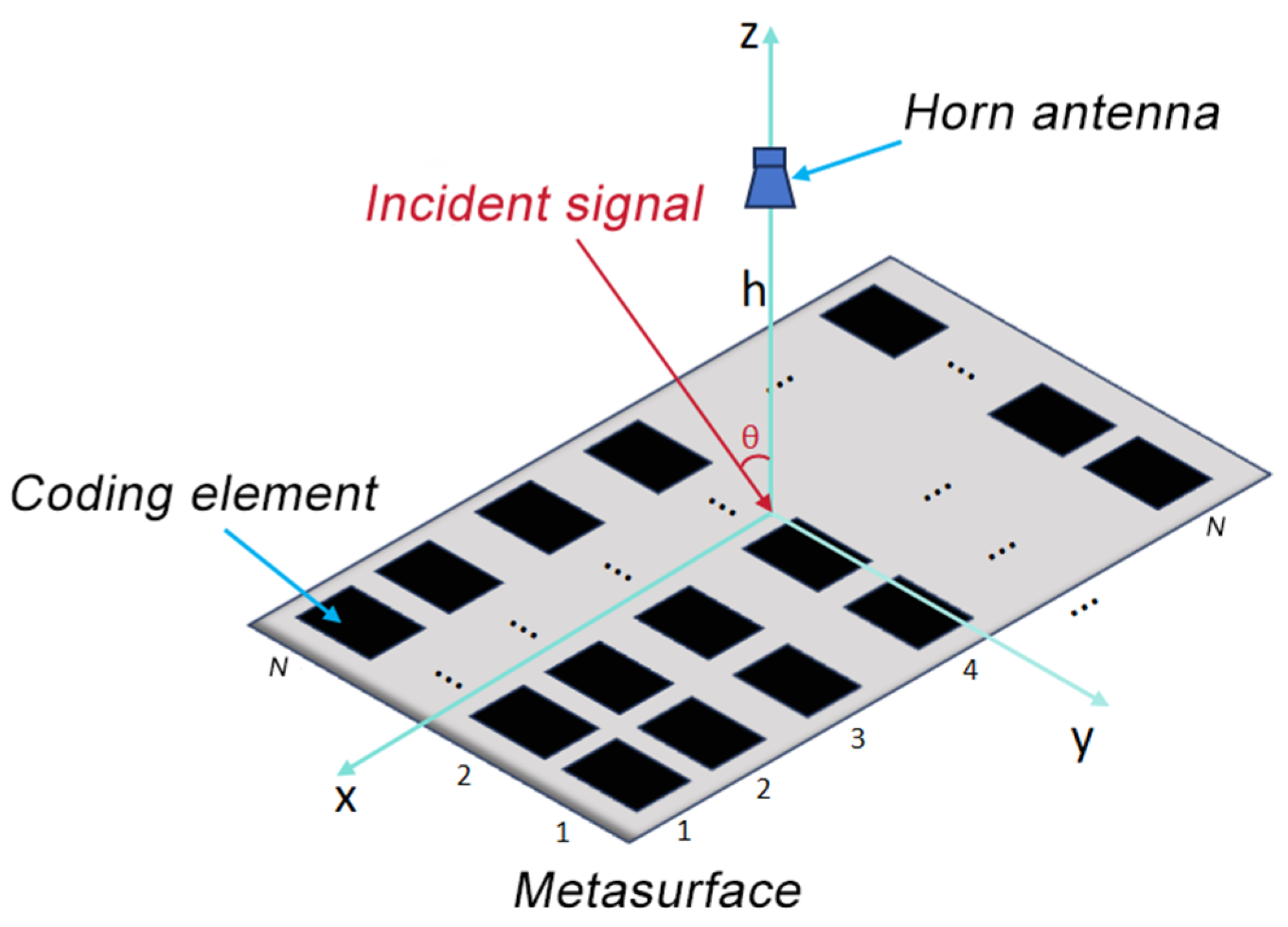




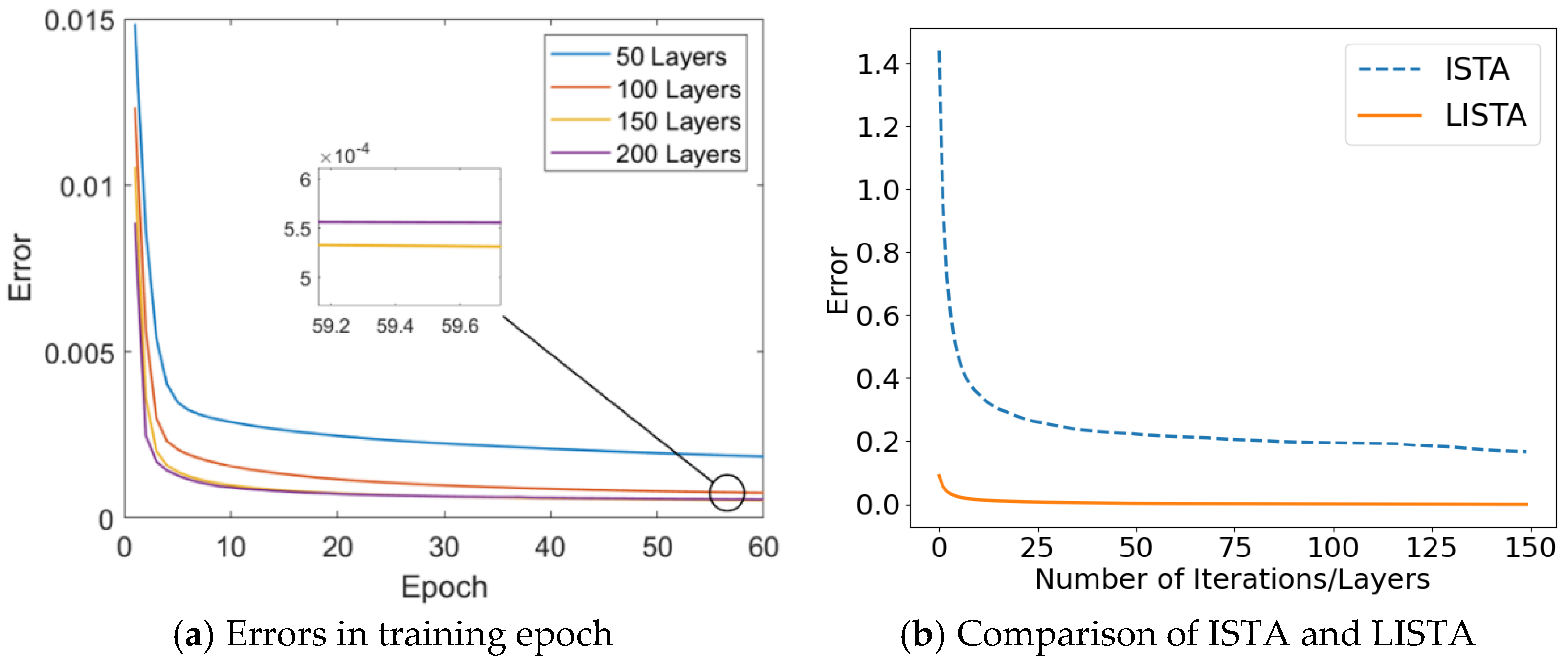
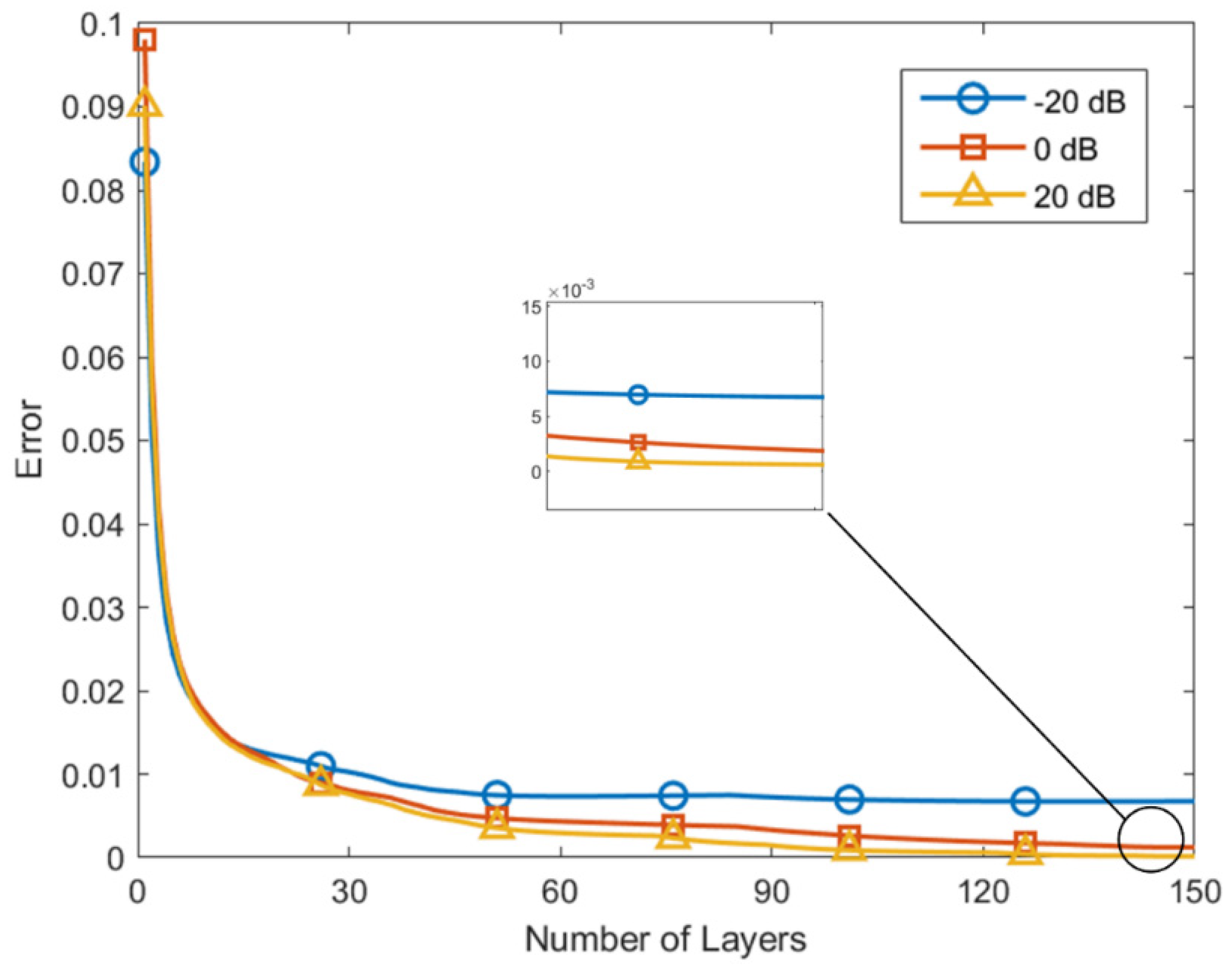
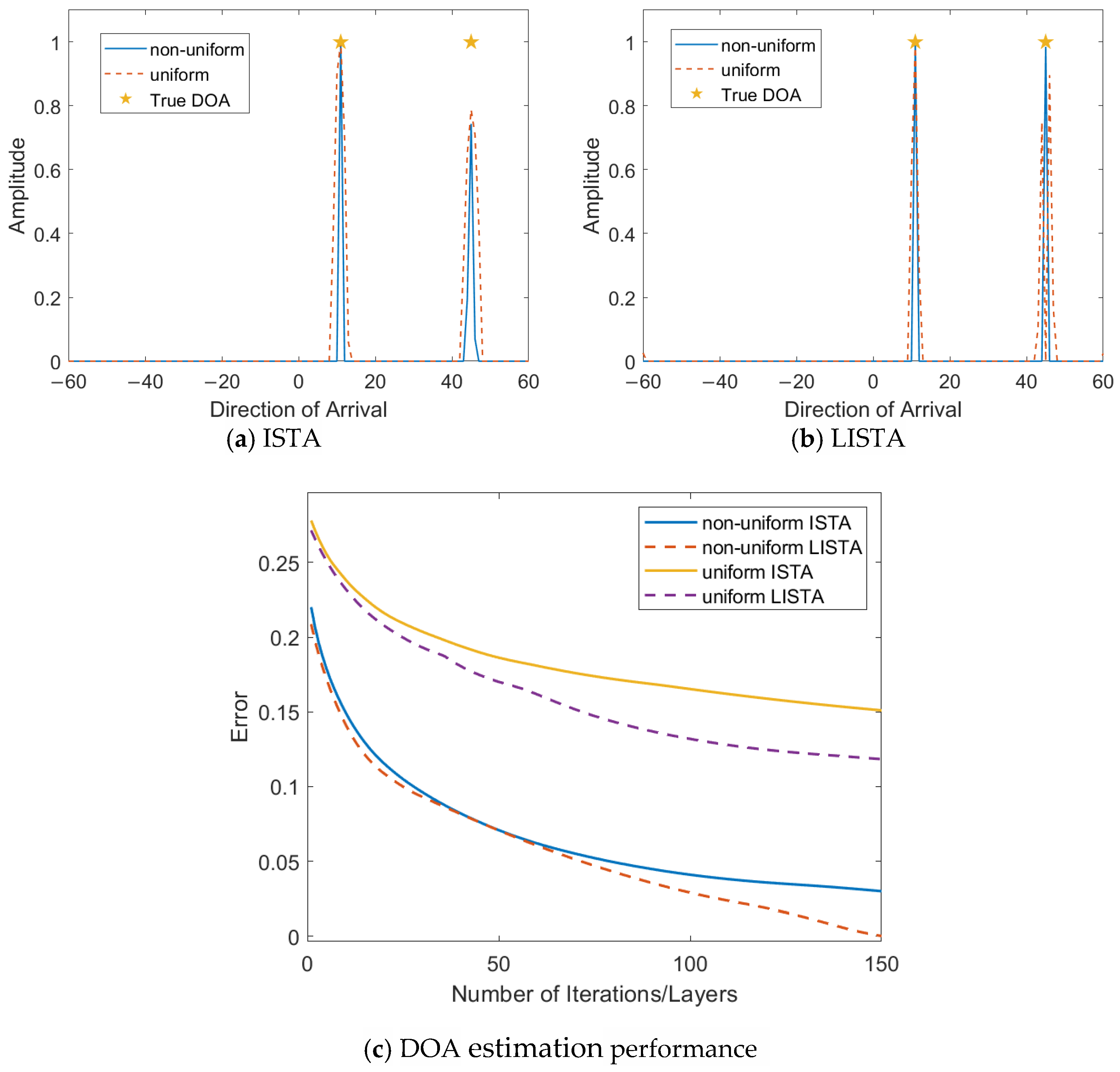
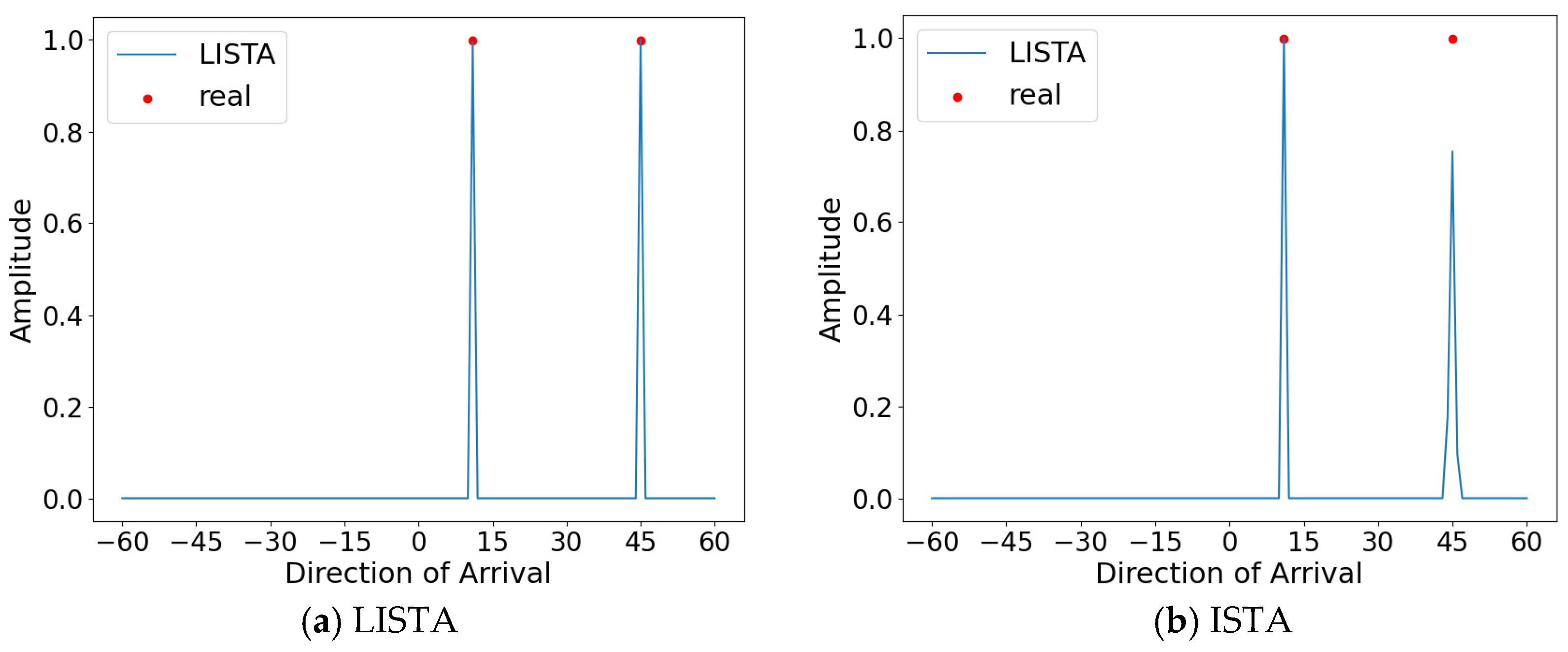
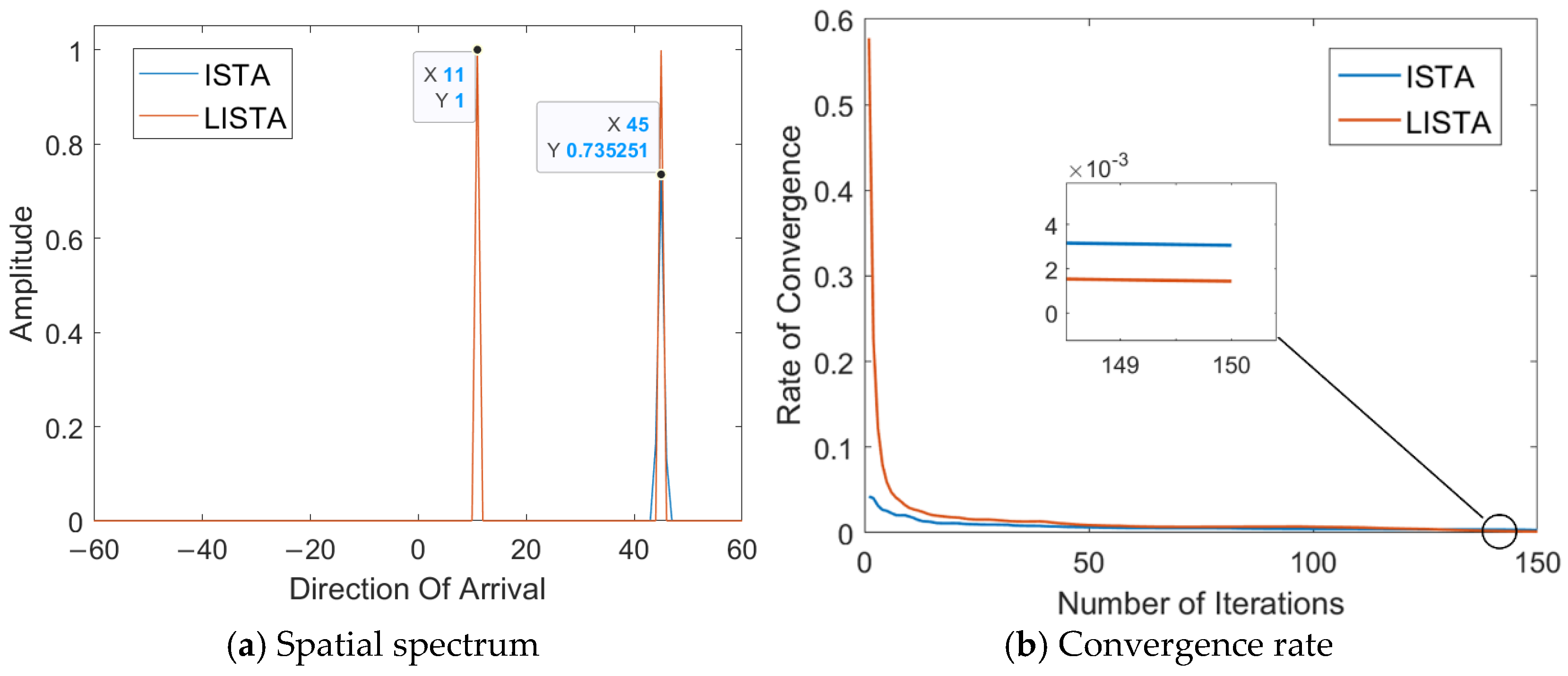
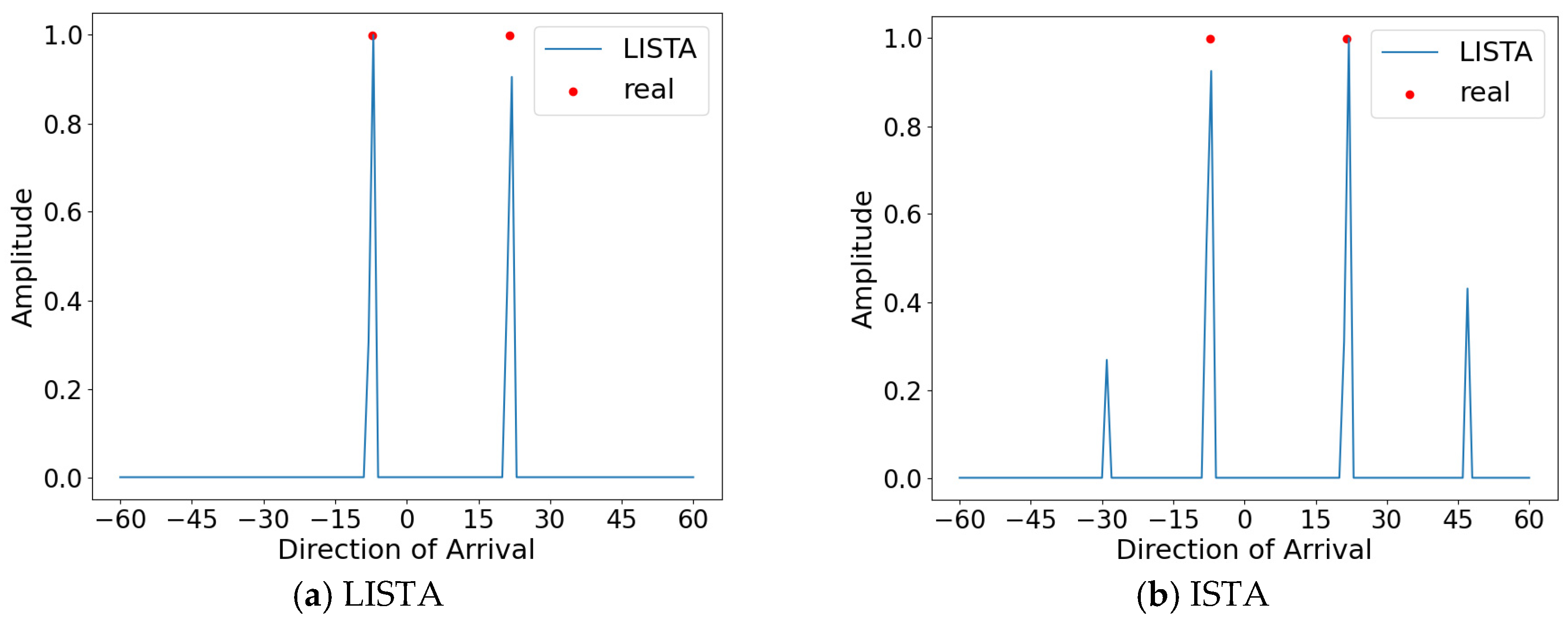
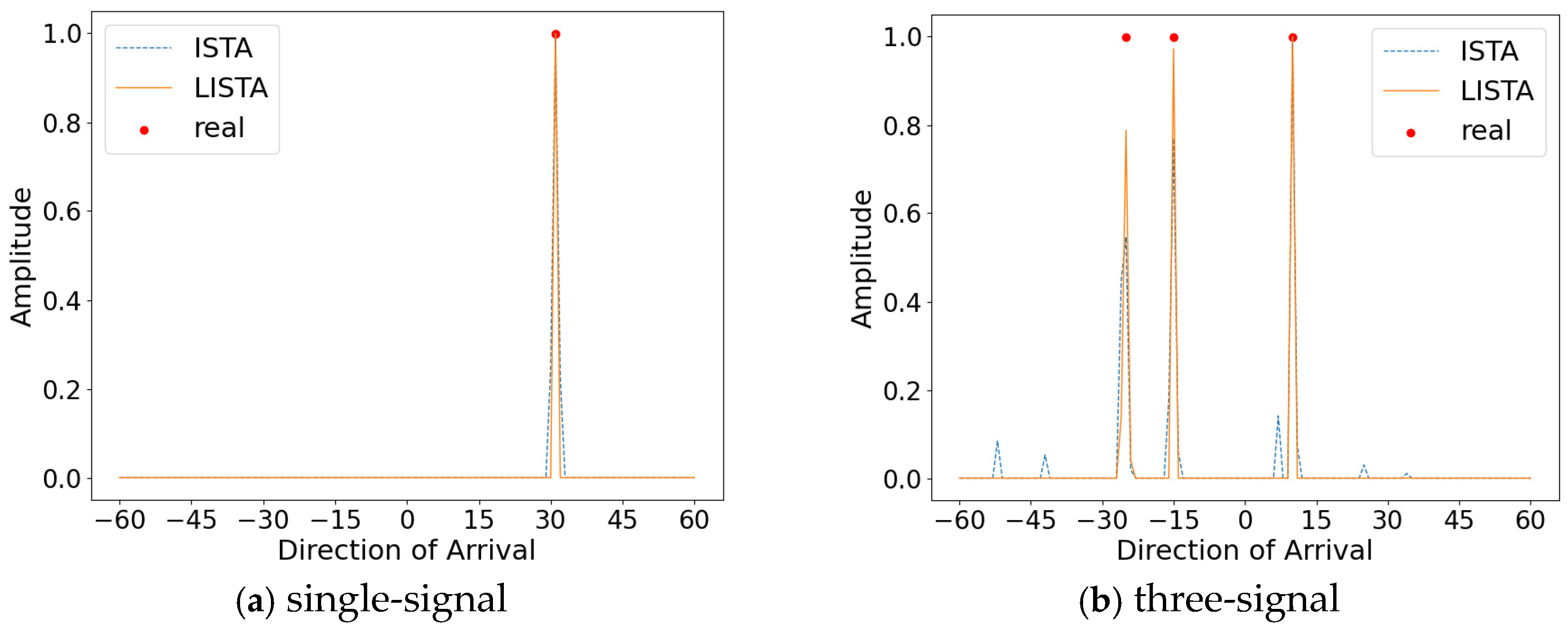

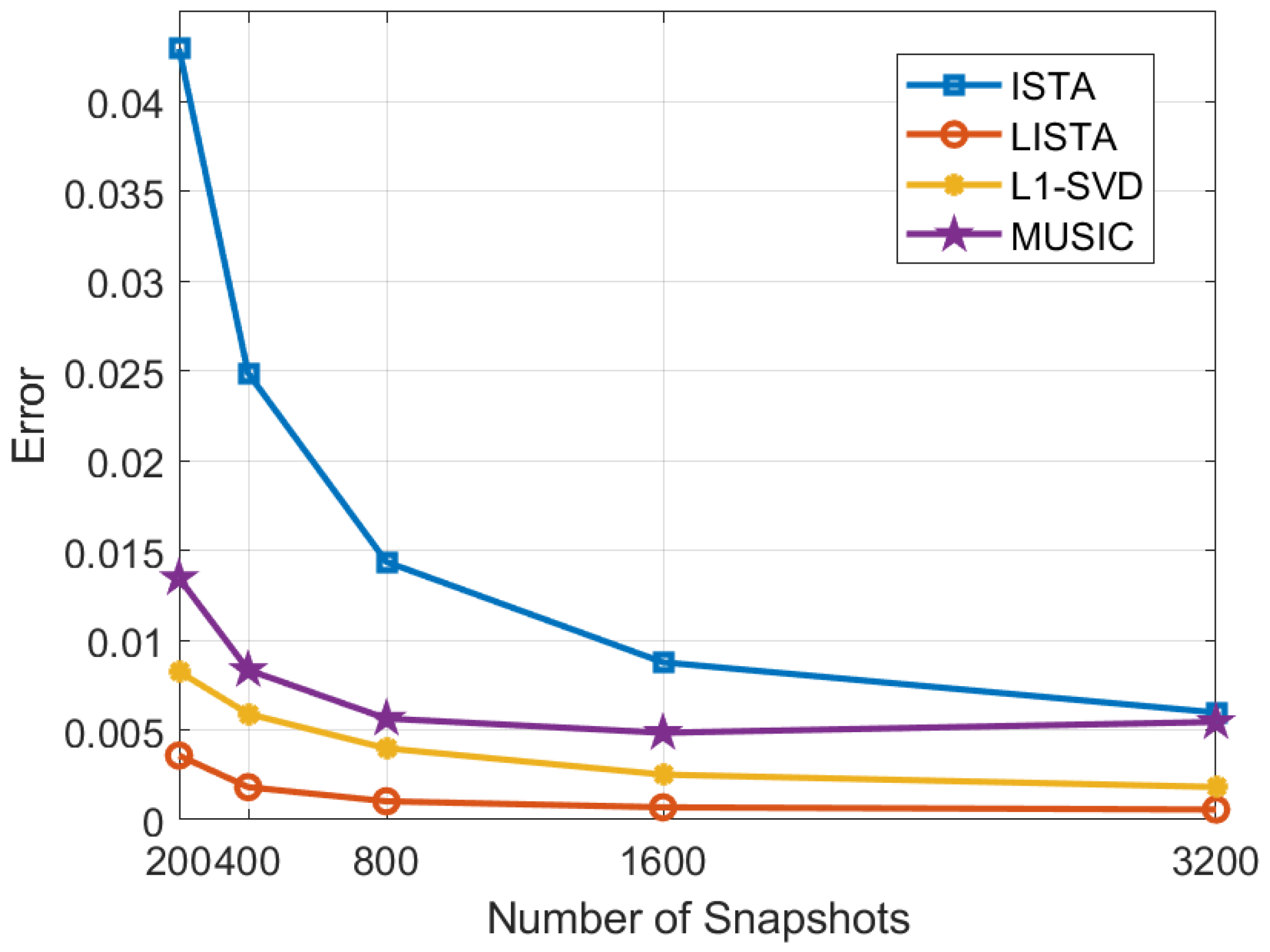
| Algorithm | LISTA | ISTA | MUSIC | L1-SVD |
|---|---|---|---|---|
| Process Time | 7.4159 × 10−4 s | 9.7205 × 10−4 s | 1.2655 s | 1.1024 s |
Disclaimer/Publisher’s Note: The statements, opinions and data contained in all publications are solely those of the individual author(s) and contributor(s) and not of MDPI and/or the editor(s). MDPI and/or the editor(s) disclaim responsibility for any injury to people or property resulting from any ideas, methods, instructions or products referred to in the content. |
© 2025 by the authors. Licensee MDPI, Basel, Switzerland. This article is an open access article distributed under the terms and conditions of the Creative Commons Attribution (CC BY) license (https://creativecommons.org/licenses/by/4.0/).
Share and Cite
Niu, X.; Su, X.; He, L.; Chen, G. Direction of Arrival (DOA) Estimation Using a Deep Unfolded Learned Iterative Shrinkage Thresholding Algorithm (LISTA) Network in a Non-Uniform Metasurface. Remote Sens. 2025, 17, 1253. https://doi.org/10.3390/rs17071253
Niu X, Su X, He L, Chen G. Direction of Arrival (DOA) Estimation Using a Deep Unfolded Learned Iterative Shrinkage Thresholding Algorithm (LISTA) Network in a Non-Uniform Metasurface. Remote Sensing. 2025; 17(7):1253. https://doi.org/10.3390/rs17071253
Chicago/Turabian StyleNiu, Xinyi, Xiaolong Su, Lida He, and Guanchao Chen. 2025. "Direction of Arrival (DOA) Estimation Using a Deep Unfolded Learned Iterative Shrinkage Thresholding Algorithm (LISTA) Network in a Non-Uniform Metasurface" Remote Sensing 17, no. 7: 1253. https://doi.org/10.3390/rs17071253
APA StyleNiu, X., Su, X., He, L., & Chen, G. (2025). Direction of Arrival (DOA) Estimation Using a Deep Unfolded Learned Iterative Shrinkage Thresholding Algorithm (LISTA) Network in a Non-Uniform Metasurface. Remote Sensing, 17(7), 1253. https://doi.org/10.3390/rs17071253





